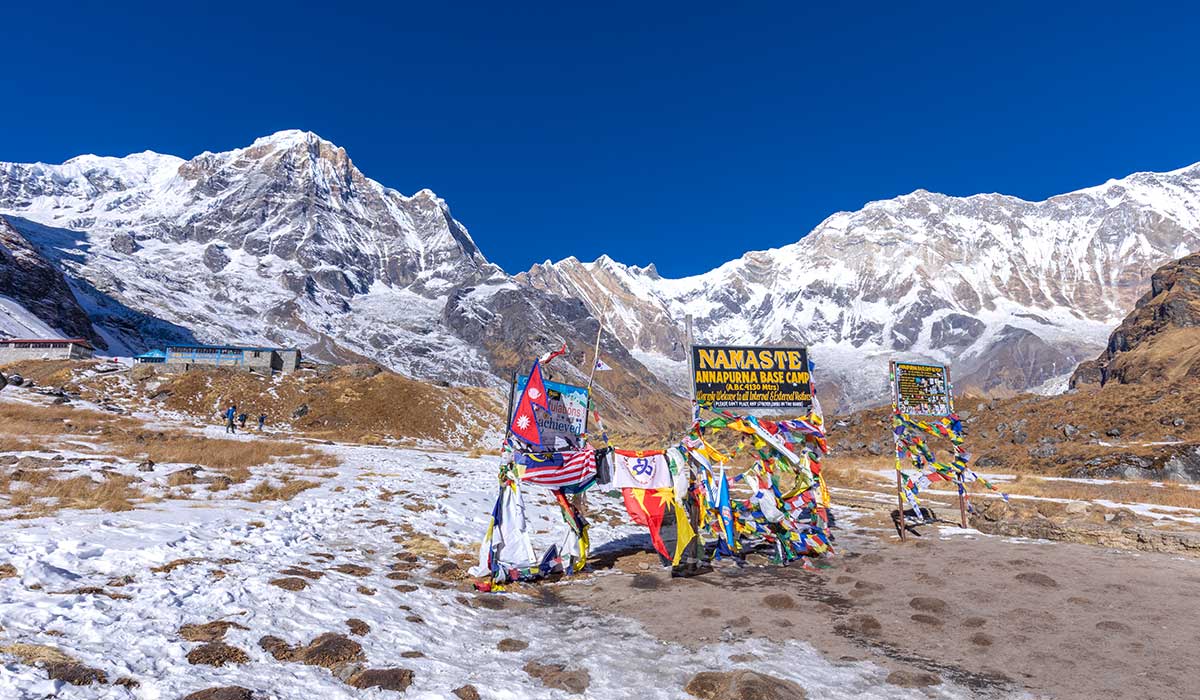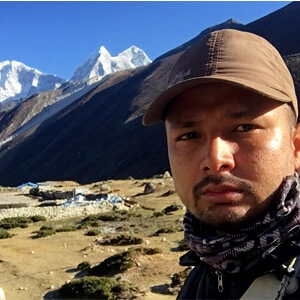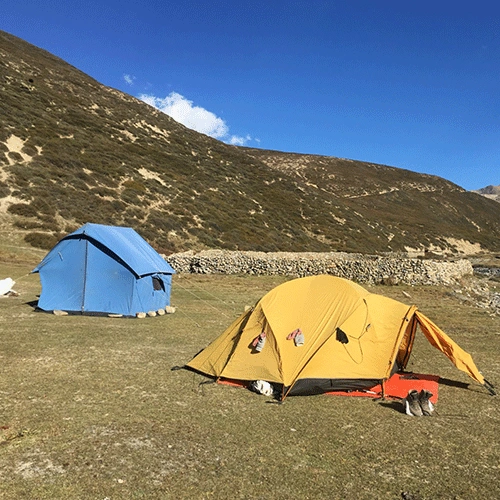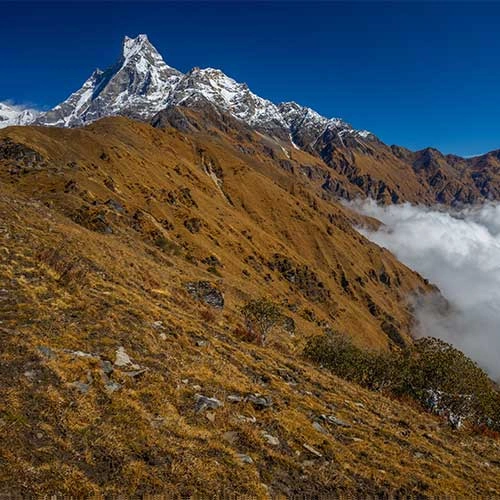Why May is the Perfect Time for the Annapurna Base Camp Trek?
Stable Weather
May is part of the spring, which is the peak period for trekking and mountaineering in Nepal. Thus, during your Annapurna Base Camp Trek in May, you can expect favorable weather conditions and pleasantries to make your experience even more exciting.
Normally, May offers clear skies, dry and comfortable trekking trails, minimal rainfall, and pleasant temperatures, making it one of the best times to fully enjoy your outdoor trip to ABC. Overall, this month provides ideal conditions for a memorable trekking experience.
Moreover, the stable weather factors also significantly reduce the difficulty level of the trek, which is higher during the off-trekking periods.
Majestic Mountain Views
This classical Himalayan base camp adventure rewards you with majestic views of stunning peaks like Annapurna I, Annapurna III, Annapurna South, Gangapurna, Himalchuli, Machhapuchhre, Gandarva Chuli, and several other adjacent mountains.
Annapurna Base Camp in May, which has a favorable climate, makes the view even more enchanting under the endless blue sky. The view is clear from morning to late afternoon, so you will have more chances of soaking in the pristine beauty of the peak across your trekking route.
Vibrant Landscape and Rhododendron Blooms
If you haven’t visited Nepal before, spring is the time of nature when beautiful blooms take over the landscape of the country. During your base camp trek, you will take your time admiring the diverse beauty of the landscape, from the lower trail to the alpine meadows.
In the lower part of the trails, the forests are covered with lush rhododendron blooms. The colorful vibrance of this national flower, from pink to deep red, and other wildflowers add a magical touch to your journey.
Similarly, the lushness is spread even across the highest part of the region and walking through the majestic landscape will feel like a journey across a natural wonderland.
Longer Daylight Hours
Even among the peak seasons, spring houses longer daylight hours. This means you will have more time to explore and immerse yourself in the Himalayan experience during your Annapurna Base Camp Trek in May.
Thanks to the long daylight hours this month, you will be able to take it slow with your journey and extend your exploration activities. That’s why doing ABC Trek in this month is especially beneficial for those trekkers who want to take their time to experience the journey, not just walk and have more free time while following a standard itinerary package.
Easy Trail Navigation
During the peak travel seasons, tourism activities increase in this second most popular Himalayan trekking destination. Thus, the trails are well-maintained and marked for you to traverse without any issues.
Similarly, unlike the snow-covered path of winter and slippery, challenging trails of monsoon, you will find it much easier to navigate the route. This is especially beneficial for independent trekkers who are trekking with minimum guidance and first-time trekkers who have yet to embrace every side of the mountain route.
Wildlife Spotting
As spring is the prime season for nature, it doesn’t only refer to the blooming landscape. The wildlife of the region is also more active during this period as winter snow starts to melt and the landscapes regain their former glory.
The hibernating animals also wake up from their long slumber and are on the hunt for food to sustain their hunger. So, while moving along the exciting trails of this base camp adventure, you will have a high chance of crossing paths with the rare Himalayan wildlife species.
Cultural Immersion
Nepal is a cultural hub, home to 142 ethnic groups, and beautiful and colorful celebrations take place here every month throughout the year. During your Annapurna Base Camp Trek in May as well, you will have the chance to admire some of the most unique and exciting celebrations.
Bisket Jatra, Nepali New Year, Buddha Jayanti, and Machhdendranath Jatra are some incredible festivals that are celebrated in Nepal in May. Thus, witnessing these amazing festivals from up close will provide you with immense cultural exposure, which will be an unforgettable add-on to your Himalayan journey.

Weather and Temperature in May at Annapurna Base Camp
May is the final month of the spring season before the monsoon season starts in full swing. Thus, in this transitioning month, you can expect warm and comfortable temperatures across the trekking route. The temperatures are neither too hot nor too cold and just perfect for outdoor activities during May.
In general, the Annapurna Base Camp Temperature in May hovers around 15°C to 20°C during this part of the year at the lower elevations. As you climb higher, close to the alpine altitudes, you will slight fall in temperatures. At the higher points of the trail, the temperature in the Annapurna region averages around 12°C.
Similarly, during the night and early morning, the temperatures can drop up to -5°C. So, it will be best if you pack for the trek considering these factors to keep yourself comfortable across different climatic zones.
The skies are generally clear for the most part and will offer you clear views of the landscape and mountains. Although there is a low probability of pre-monsoon showers if you are traveling during the latter part of the month, they are typically brief and occur during the late afternoon.
Crowd Levels on the ABC Trek in May
Doing the Annapurna Base Camp Trek in May means exploring this classical route during one of the peak travel seasons in the country. However, this month is not the peak point of the spring season, which is April.
So, even if there are people on the trail during this month, you can expect the crowd to be smaller than in April. The teahouses, as well as mainstream trails, are not overwhelmingly packed. You will be able to take it easy and won’t feel rushed during your trek.
During May, the trekking trail offers a perfect balance between solitude and companionship. You’ll meet fellow trekkers at teahouses and scenic spots along the route, but the trail never feels overcrowded or congested.
This moderate flow of trekkers creates a comfortable atmosphere, providing both safety in numbers and chances for meaningful interactions, while still allowing you to enjoy personal space and moments of quiet. Most trekkers typically start their day’s journey between 7:00 and 8:00 AM, keeping the trail active but never overwhelming.
If you get started with your part slightly earlier or later than the peak hours, it can ensure more peaceful stretches across the route. Early arrival at the teahouses in your destination also helps you secure the best spots to enjoy the majestic views and quiet evenings.
What to Pack for the ABC Trek in May?
Packing for the Annapurna Base Camp Trek in May means dabbling to find a balance between managing the essentials and packing light at the same time. Foremost, you should consider the appropriate clothing for your trip.
Make sure to pack comfortable and lightweight clothes for the lower trails, such as t-shirts, thermal leggings, and shirts. Then, find a balance between the mid-layers with flexible layers like a fleece jacket, light sweater, thermal vest, etc.
For the outer protective layer, you should bring insulated and windproof/waterproof shells. Don’t forget comfortable trekking boots, slippers, sports shoes, an insulated hat, sunhat, sunglasses, neck gaiter, etc, to deal with Himalayan weather.
Similarly, you should bring all the essential personal hygiene and toiletry products. As for the essential gear, you can include a sleeping bag, backpack, headlamp, trekking pole, reusable water bottle, power bank, dry bags, camera, etc.
Learn More About:Clothing and Equipment List
Accommodation Options on the Trek During May
Teahouses and lodges across the trail during the Annapurna Base Camp Trek in May remain fully open and operational. In a standard trekking package, you will be staying at the teahouses, which will provide basic and comfortable amenities.
The rooms at the teahouses have mostly two to three beds in a single room. They will provide basic facilities like beds with blankets, basic meals and a standard bathroom. So, in overall, even the standard accommodation option will provide a comfortable experience.
As for the lodges, they are more of a luxury option in this classical trekking route. The services provided by the lodges are extensive and high-end. If you don’t want to compromise comfort during your trek, this is the ideal accommodation option.
For this mainstream trekking region, we recommend you book in advance. This will provide you with the opportunity to surf through popular accommodation options on the route and you can choose the best one that suits your preferences.
Essential Permits Required for the ABC Trek
For the Annapurna Base Camp in May, you will have to get two permits. These permits are mandatory for this base camp route and traveling without permits can result in a fine and permanent ban. So, make sure to collect these permits for your adventure.
Permits for Annapurna Base Camp Trek
- Annapurna Conservation Area Permit (ACAP) US$30
- TIMS (Trekker’s Information Management System) Card US$20
The conservation area permit will give you access to the largest conservation area in Nepal. As for the TIMS Card, it is more of a safety measure that will keep track of your journey and checkpoints across the route. The TIMS Card has been recently brought into circulation in Nepal to enhance the safety and security features for trekkers.
These permits can be collected either in Kathmandu or Pokhara at the tourism board office. For your trip with Green Society Adventure, we will apply and collect these permits for you. This way, you will be able to enjoy a seamless journey without any issues.
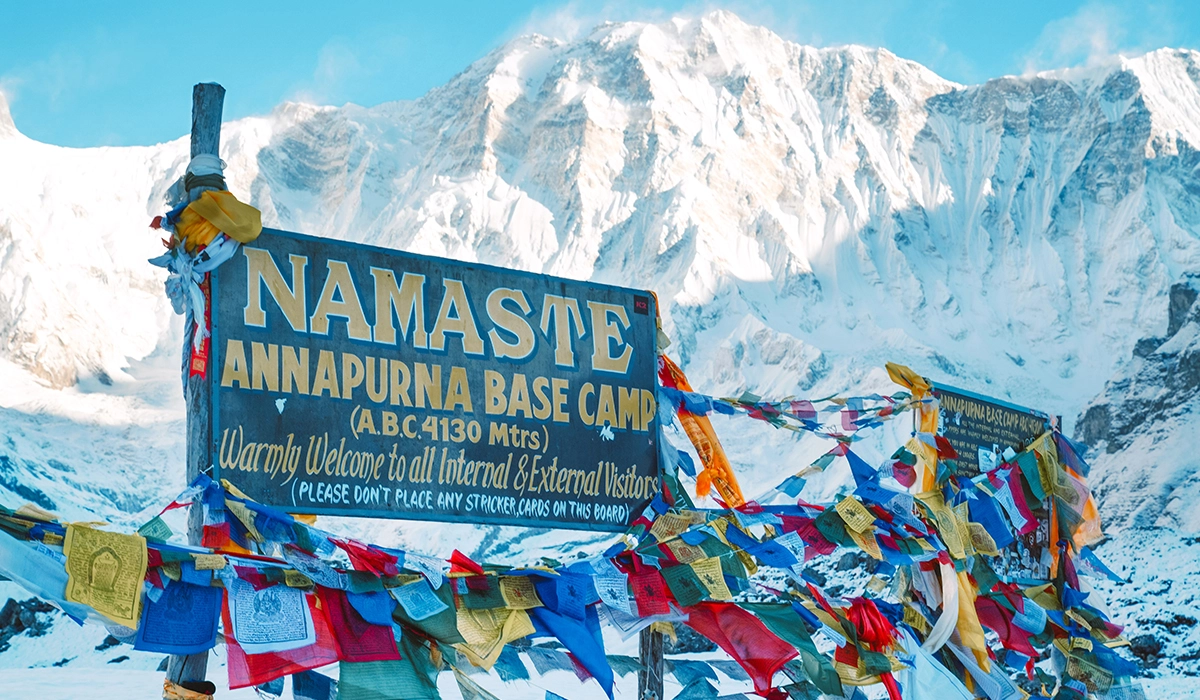
Altitude and Acclimatization Tips for May Trekkers
Although the risk of altitude sickness during the Annapurna Base Camp Trek in May is lower due to weather favorability, you will still need to be careful. Trekkers may have to deal with symptoms of altitude sickness after crossing an altitude of 2,500 meters (8,202 feet).
The symptoms of altitude sickness can vary from person to person. So, it is important to be watchful about the general symptoms and follow a strategic acclimatization process. Due to warmer climatic conditions in the spring, there is a lower risk of altitude sickness.
Still, it will be better if you are wary about the symptoms of altitude sickness, such as nausea, headache, dizziness, shortness of breath, loss of appetite, coughing, chest tightness, congestion, etc.
The best way to prevent altitude sickness is to acclimatize enough before heading to the higher part of the trail. Similarly, it is also important to stay hydrated and eat a balanced diet. You also need to avoid over-exhaustion and take altitude sickness medicines if necessary.
Our 13 Days Annapurna Base Camp Trek follows a steady pace on the mountain route and you will also have ample time to adapt to the rising altitudes. Moreover, our itinerary plan has been crafted with the help of veteran guides and travel experts, so there won’t be any complications whatsoever.
So, even a complete beginner won’t find it hard to move along with our itinerary plans on this Himalayan journey.
Find Out More About:What is Altitude Sickness? Know Before You Go for Himalayan Treks
How to Train for the ABC Trek in May?
The preparation level for the Annapurna Base Camp Trek in May will depend on your overall fitness level. ABC Trek has a mild difficulty level and is considered a relatively easier adventure compared to other high-pass and base camp adventures.
However, you should still prepare diligently for the trip to secure a comfortable experience. For this classical base camp trek, you need to physically prepare for about 3 to 8 weeks. If you are physically fit and have a healthy routine for workouts, you don’t need to schedule a lot of hours for training.
Your training program should be a combination of strength, endurance and cardio exercises. Similarly, balance and flexibility exercises will be equally helpful to reduce the strains on the joints and move comfortably across the uneven Himalayan route.
For effective physical training, you should consider including practice hikes in your training. Doing hikes at steep segments will simulate an identical trekking experience like in the Himalayan route and you will also get a chance to check out the comfort level of your trekking gear.
Similarly, hiking is a wonderful opportunity to practice acclimatization. You will be able to check how your body reacts at different altitudes and tain efficiently to prepare for the high altitude factors of the ABC Trek.
Health and Safety Tips for Annapurna Base Camp Trek in May
Annapurna Base Camp trek is a well-established route and is relatively safe, but it is important to be mindful of the health and safety factors to make your journey enjoyable. During the trek, you need to stay on the designated and marked trail to avoid the risk of encountering dangerous terrain or wildlife.
You should also be wary of the weather factors at higher altitudes and make preparations accordingly. Similarly, you should also be aware of altitude sickness and carry emergency contact information to request for help if needed.
Likewise, protect your valuables, avoid roaming around after dark and follow the trail safety guidelines with utmost priority. That’s why hiring a licensed guide or doing a trek with a reputable agency is the best way to enjoy the experience without worrying about health and safety factors.
If you do this trek with Green Society Adventure, we will provide all the safety details for your trip. Our experienced guides will evaluate every factor for each day’s exploration. Moreover, our guides are also proficient in high-altitude and first-aid treatment.
The crew will monitor your safety, health and comfort throughout the trek. During emergencies, the guide will take the necessary measures after coordinating our head office. So, your trip with us will be a safe, remarkable and unforgettable experience.
Day-by-Day Itinerary for the ABC Trek in May
Our 13-Day Annapurna Base Camp Trek follows the standard itinerary plans on this classical route. For a better understanding of our trip, here is the trip outline of the ABC Trek in May.
Annapurna Base Camp Trek in May: Outline Itinerary
Day 01: Arrival in Kathmandu (1,320m/ 4,329ft) and hotel transfer
Day 02: Drive to Pokhara (820m/ 2,690ft): 7 to 8 hours (30 minutes flight option is also available at extra cost)
Day 03: Drive to Hile (1,960m/ 6,428ft) from Pokhara and trek to Ulleri (2,050m/ 6,725ft): 2 hours drive and 4 hours trek
Day 04: Trekking from Ulleri to Ghorepani (2,860m/ 9,380ft): 5 hours
Day 05: Hike in the morning to Poon Hill (3,210m/ 10,528ft) and trek to Tadapani (2,630m/ 8,626ft): 6 hours
Day 06: Trek to Chhomrong (2,170m/ 7,118ft): 5 hours
Day 07: Chhomrong to Dovan (2,570m/ 8,430ft) trekking: 5 to 6 hours
Day 08: Dovan to Deurali (3,230m/ 10,059ft): 5 hours
Day 09: Trekking from Deurali to Annapurna Base Camp (4,130m/ 11,250ft): 5 to 6 hours
Day 10: ABC to Bamboo (2,310m/ 7,578ft): 6 to 7 hours
Day 11: Trekking to Jhinu Danda (1,780m/ 5,838ft): 6 hours
Day 12: Trek to Siwa/Ghandruk Phedi (1,150m/ 3,772ft) and drive back to Pokhara or trek to Nayapool (1,070m/ 3,510ft) and drive back to Pokhara: 5 to 6 hours
Day 13: Drive back to Kathmandu (1,320m/ 4,329ft) and farewell dinner: 7 to 8 hours
Although this is a standard itinerary plan for this base camp adventure, we also offer customization options. With us, you will be able to enjoy an ionic experience personalized to meet your preference.
In our customization option, you can freely decide on the number of days for the trek, the walking speed you prefer, the number of rest days, the grade of accommodation, the number of guides/porters, side extensions to other major highlights, etc.
Foods and Drinks to Try Along the ABC Trek in May
As doing the Annapurna Base Camp Trek in May means enjoying the benefits of peak season, you will have no room to complain about the food and drink aspects. This mainstream trekking region has been properly developed to cater to the needs of the large inflow of travelers.
For meals, there is a wide range of options to choose from traditional to international menus. The most popular traditional items that you should at least once in the central Himalayan route are Dal Bhat, Gurung Bread, Momo, Thukpa, Shyphale, Yak Cheese, Dhido Gundruk, etc.
Similarly, the teahouses/lodges across the route also offer international delicacies such as Pizza, Burger, Spaghetti, Fries, Steak, pasta, Salad, Pie, Toast, Soup, etc. You will also have the option to request to customize the ingredients for your meal. So, even vegans and vegetarians won’t have any issues enjoying the meal of their preference.
You May Like:Himalayan Food: Most Popular Himalayan Food in Nepal
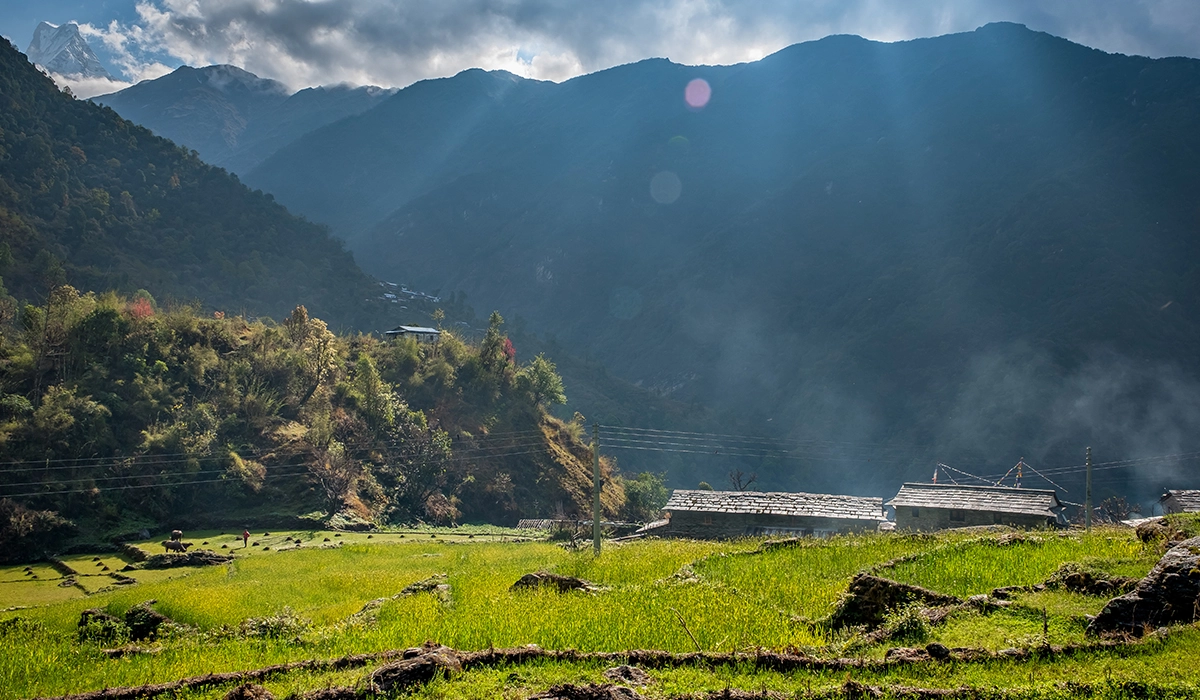
What About Drinks?
As for the food option, you can enjoy various delights, for the drinks as well. Masala Chiya, Butter Tea, Lemon Ginger Honey Tea, etc are some popular choices. Similarly, cold drinks and alcoholic beverages from Raksi and Tongba to labeled wine are also available here.
But we recommend you not consume any alcoholic beverages during the trek. Drinking alcoholic beverages can elevate the risk factors and can also affect the acclimatization schedule.
For drinking water, you can purchase water bottles or filtered water that are sold at the teahouses. There are also clean water stations across the route. However, purify the water with a purifying solution or tablet before consuming it if you are filling your bottles at clean stations.

